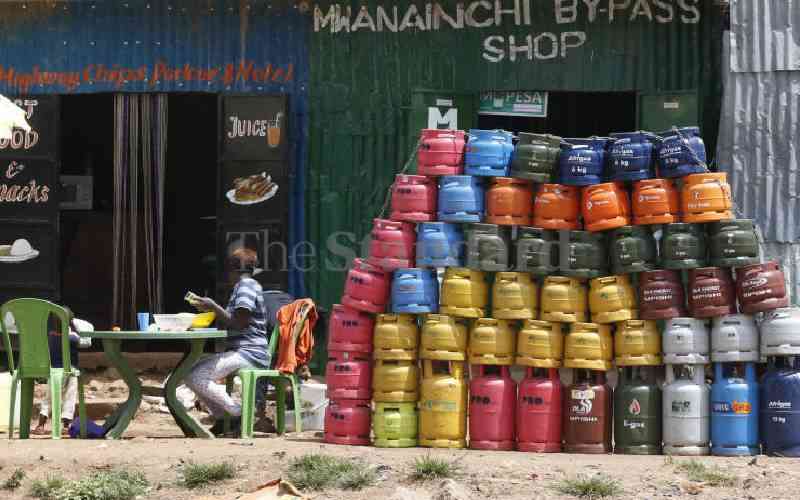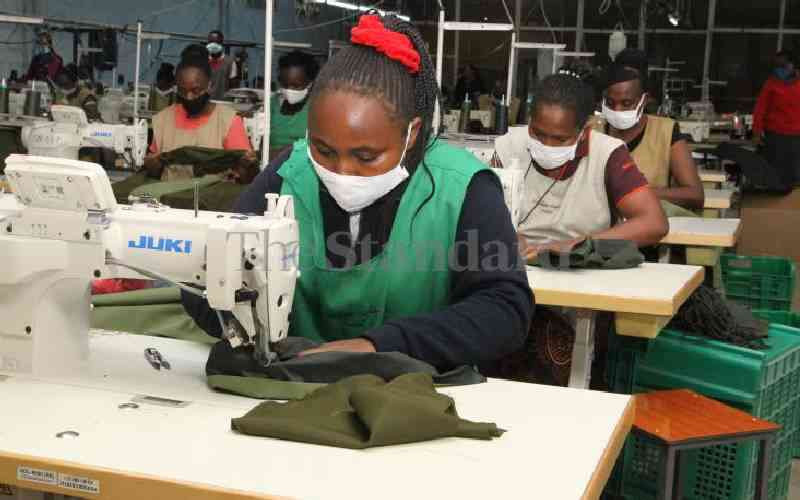The vast mineral resources in Kitui County have seen several firms work overtime to elbow out their rivals in a bid to stake a claim to the billions of shillings buried underground.
The county is endowed with huge reserves of coal in Mui Basin, with a Chinese firm, Fenxi Industry Mining Group, winning the concession to mine it. There are also enviable iron ore deposits in the county’s Ikutha district.
But it is the discovery of limestone deposits in Kanziku, Mathima, Simisi and Ngaaie areas that has more recently drawn the attention of some of the region’s largest manufacturers looking to expand their business portfolios.
Some of the reserves are said to hold enough limestone to last cement companies more than 50 years.
East Africa’s economic growth is largely centred around infrastructure, which has contributed to the region’s biggest growth spurt in three decades.
In Kenya, cement consumption, a key indicator in the construction industry, increased 21.8 per cent in 2014 to 5.2 million tonnes. The construction sector as a whole registered 13.1 per cent growth last year, according to the 2015 Economic Survey, which attributed the performance largely to increased investments in road and rail construction.
Limestone is a central element to this sector. The mineral is burned at very high temperatures to make clinker, which is then mixed with gypsum to produce cement.
There are two types of cement plants: an integrated plant, where clinker is produced and then mixed with gypsum to make cement; and a grinding plant, where clinker is either imported or bought locally from a competitor who has it, and then mixed with gypsum to produce cement.
Those who have access to limestone deposits have a competitive advantage as they can produce their own clinker, which means they hold on to a larger share of profits.
Most manufacturers import semi-finished cement or clinker from China and the Middle East, and then grind it into cement. In 2012 alone, more than 1.2 million tonnes of clinker were imported.
Bigger potential
The bottom line is the greater the amount of cement a factory can churn out, the bigger the potential it has to play a central role in East Africa’s infrastructure-driven growth.
This explains the latest scramble for limestone, with this round roping in major cement manufacturers ARM Cement and Dangote Quarries, which is owned by Nigerian tycoon Aliko Dangote.
The two firms have expressed their willingness to set up multi-billion-shilling cement processing plants in Kitui.
Although others, such as the East African Portland Cement Company (EAPCC) and Bamburi Cement, have remained mum about their plans, it is believed that they are also positioning themselves to strike deals with the Kitui County government and secure a section of the limestone deposits for their expansion.
EAPCC was among the first companies to prospect for limestone in the Mutomo region of Kitui before the establishment of county governments. At the time, ARM and Bamburi had also pitched camp to carry out their own explorations.
The entry of ARM and Dangote Quarries rekindles memories of the tussle some years back between Bamburi Cement and ARM for the control of a 180-square-kilometre piece of land endowed with limestone in Kanziku area, Kitui South sub-county.
The battle ended up in court, where Bamburi Cement appeared to lose the fire to fight and took a backseat while ARM made a spirited case for itself.
More recently, ARM, which is listed on the Nairobi Securities Exchange (NSE), has once again taken the lead, and may become the company that gives Kitui County its first cement factory.
It has shifted its focus from Kitui South and done quiet prospecting in Ngaaie, Mwingi North sub-county, which holds limestone deposits within and around the Ngaaie hills.
The company plans to put up a Sh26 billion factory in the area and has already negotiated with the landowners who will be displaced by the massive project. They are expected to receive Sh150,000 per acre in compensation.
Major development
The limestone-rich area covers 3,500 acres, and the project is expected to displace around 2,000 people.
“It is a major development for us. We will offer 2,000 jobs directly, and another 1,500 jobs indirectly to the local residents,” said Pradeep Paunrana, ARM’s managing director.
He, however, has opted to remain tight-lipped on the finer details of the company’s plans given the competitive nature of the industry it operates in.
The company is now working on a resettlement action plan that will detail how the displaced will be relocated and resettled.
Once the document is approved by the Ministry of Mining, ARM expects to be issued with a licence to begin construction.
Kitui Governor Julius Malombe has assured Ngaaie residents that his administration is working closely with the firm to ensure the resettlement is done in a fair way.
“We have put in place measures to ensure the displaced people are resettled in a proper manner; we don’t want our people to be left destitute after they are moved,” Dr Malombe told residents during a recent visit to the area.
He added that once the process is finalised, the company would be tasked to upgrade health facilities and schools in the area as part of its corporate social responsibility.
The vice chairman of the Ngaaie Liaison Committee, Muthisya Mutembei, said three-quarters of those to be moved from Ngaaie have alternative land they can settle on.
“A majority of these people have relatives living in the nearby areas of Kamuwongo, Tseikuru, Usueni, Mumoni, Kyuso and Mutwangombe, and are expected to relocate there,” he said.
ARM’s business plan was adopted by the county government in August last year during a meeting attended by the governor and local leaders.
Once the Kitui plant, which will have the capacity to produce 8,000 tonnes of cement daily, becomes operational, ARM will become the single-largest cement factory in the country.
Growing consumption
Adding to the intrigues of limestone harvesting in Kitui is Dangote Quarries’ recent decision to halt prospecting for limestone in Kanziku location, which has left some residents thinking the multinational firm might have pulled out of Kitui.
But John Nzuki, a linkman between Mr Dangote’s firm and the Kanziku community, said the manufacturer is still continuing with its prospecting, and it had completed the first phase and would be resuming the second and final phase this month.
Dangote, through his younger brother, Ado Dangote, held a party for Kanziku land owners in December last year, a move interpreted as an attempt to endear himself to the community.
Two parallel teams are, however, jostling over the representation of the community’s interests.
Mr Nzuki said the Ene Mali Committee, where he is patron, is the only one mandated by residents to represent them in negotiations with Dangote Quarries, adding that it is the one that gave the Nigerian firm the consent to prospect for limestone in the area.
But there is another liaison committee set up by the county government to act as the link between the investor and community.
“That other team [Ene Mali] should not divide the community. We have no idea what interests they represent. There should be a structured formula for engaging with the investor,” said George Mulatya, Kitui’s county executive in charge of Environment, Energy and Mineral Investment Development.
Mr Mulatya said the liaison committee was created to “reason and negotiate with the investor so that the community does not get a raw deal.”
The chairman of the county liaison committee, Vincent Mutambu, added that Ene Mali is part of the Kanziku community, and as such, their interests are represented by his committee.
But Wilfred Mutuva, a member of Ene Mali, differed with these sentiments, saying: “There is zero relationship between our team and the liaison committee. They cannot represent us in limestone deals.”
He added that his team is also wooing others cement manufacturers to invest in the region.
But it is feared that such in-fighting might scare away investors.
Dangote plans to establish a Sh34.8 billion cement plant in the county to produce 5,500 tonnes of cement daily.
New legislation
To safeguard county residents’ interests, Mulatya’s office has formulated new guidelines that, among other things, state that investors interested in Kitui’s minerals will not be allowed to buy land; rather, they will be required to lease it.
Muusya Mwinzi, the chief officer in the county’s minerals and energy docket, said this is meant to protect residents from exploitation.
“With a lease, locals are able to get a lump sum amount and yearly payments. This is not possible if the investors buy the land,” Dr Mwinzi said.
He added that apart from Kanziku, Simisi, Mathima and Ngaaie areas, which are traditionally endowed with massive limestone reserves, the same resource has recently been discovered in other parts of the county, including Thaana Nzau, Tharaka and even inside the Mui coal basin.
However, firms that have prospected for limestone in these areas have not shared their reports with the county on the quantities and commercial viability of the resource, Mwinzi said.
“As such, we can’t exactly tell the monetary worth of the resource. However, we are partnering with South Eastern Kenya University’s department of geology and mines to map out areas with mineral resources, and establish their quantities and commercial value.”
Kitui’s limestone industry is expected to become an even bigger asset once the Mui coal power project is actualised, as most cement firms have turned from expensive oil fuel to coal to power their machines.
 The Standard Group Plc is a multi-media organization with investments in media
platforms spanning newspaper print operations, television, radio broadcasting,
digital and online services. The Standard Group is recognized as a leading
multi-media house in Kenya with a key influence in matters of national and
international interest.
The Standard Group Plc is a multi-media organization with investments in media
platforms spanning newspaper print operations, television, radio broadcasting,
digital and online services. The Standard Group is recognized as a leading
multi-media house in Kenya with a key influence in matters of national and
international interest.
 The Standard Group Plc is a multi-media organization with investments in media
platforms spanning newspaper print operations, television, radio broadcasting,
digital and online services. The Standard Group is recognized as a leading
multi-media house in Kenya with a key influence in matters of national and
international interest.
The Standard Group Plc is a multi-media organization with investments in media
platforms spanning newspaper print operations, television, radio broadcasting,
digital and online services. The Standard Group is recognized as a leading
multi-media house in Kenya with a key influence in matters of national and
international interest.









